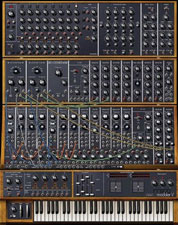 Virtual
Instruments Topics:
Virtual
Instruments Topics:
What is a Virtual Instrument?
An Improvement over the Originals
What is a Plug-in?
VIs Versus Plug-in Processors
Types of Virtual Instruments
Choosing your Computer
Plug-in and Stand-alone
Using Virtual Instruments Live
Plug-in Formats Explained
What is ReWire?
What to Look For in a Virtual
Instrument
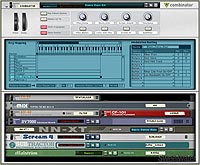 |
What is a Virtual Instrument?
A virtual instrument (VI) is software that takes advantage of your computer's processing power to create and play back sounds. It may be a software recreation, or emulation, of a hardware instrument such as an analog or digital synthesizer, electric piano, organ, or even an acoustic instrument. A VI can also take the form of a sampler. Instead of using dedicated hardware to produce sound, VI software is designed to employ your computer’s CPU. The concept of a VI came from the realization that the sound engine of a hardware digital synth was nothing more than software code and a dedicated mini computer to begin with. Therefore, it wasn’t much of a leap to import that code into a much more powerful computer such as your Mac or PC. Other advantages of using a computer are its greater memory and storage resources. This makes it possible to play back and store huge volumes of samples recorded at higher resolutions.
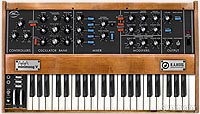 |
An Improvement over the Originals
With the advent of synthesizer modeling technology, it was discovered
that instead of using hardware, the sound of rare analog synthesizers,
organs, electric pianos, and other unique sounding and extremely
hard-to-come-by keyboards, could be emulated digitally with astonishing
accuracy. However, the digital nature of these virtual instruments, or “soft
synths” as they have come to be known, allows them to have features that go
far beyond the capabilities of many of the instruments they emulate, such as
increased polyphony and improved MIDI control.
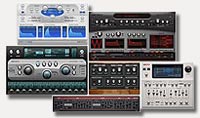 |
What is a Plug-in?
The term “plug-in” is a generic name for any piece of software that can operate inside another software environment — essentially as a “program within a program.” Plug-ins enable programs such as DAW software to add effects or sounds to their functionality without requiring users to switch to another application.
VIs Versus Plug-in Processors
In audio, when we say “plug-in,” we often think of audio processors — that is to say, tools that affect the sound passing through them without producing any sounds of their own. Examples of processor plug-ins are the 1176LN compressor and Pultec EQ found on Universal Audio’s UAD-1 card; vocal processors such as Antares Auto-Tune; as well as guitar effects, amp, and cabinet modeling plug-ins such as Native Instruments Guitar Rig and Waves GTR.
While virtual instruments also function as plug-ins, they are
sound-generating programs. Depending on the host application, a VI can
appear as simply another track (often called an “instrument track”) in your
project. It responds to MIDI notes and other control messages, and its
output can be recorded as an audio track.
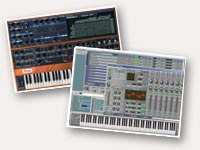 |
Types of Virtual Instruments
There are two primary types of virtual instruments. First are
sound-generating soft synths such as Arturia’s Prophet V, which employs a
sound engine that models its hardware counterpart. Other soft synths, like
the MOTU MX4, are
new instruments that never existed in hardware form. The second category of
VI is software samplers, such as Native Instruments Kontakt,
MOTU’s MachFive,
and TASCAM
GigaStudio, which are considered by many to be part of the virtual
instrument family. While some software samplers offer the ability to record
and edit digital audio data, their most common use is as a playback engine
for 3rd-party sound libraries, such as those by Ilio, East West, and
Spectrasonics.
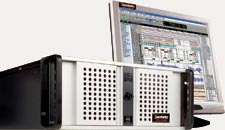 |
Choosing your Computer
Since most virtual instruments are cross platform, meaning they will work on either a Mac or PC, choosing a computer becomes a matter of personal preference. On the other hand, there are certain virtual instruments that will make the choice for you. For example, TASCAM’s GigaStudio is Windows-only software. Therefore, it makes sense to go with an audio-optimized PC such as a Sweetwater Creation Station model to run GigaStudio flawlessly out of the box.
Since each platform has software specific to it that offers distinct advantages, if your budget allows, it often pays to have both to take advantage of the inherent strengths of each. For example, you might want to dedicate your PC to GigaStudio and your Mac for recording with Digital Performer. Or, you may wish to take advantage of the loop- and music-creation capabilities of Sony ACID Pro, which is Windows software, and mix in Logic on your Mac.
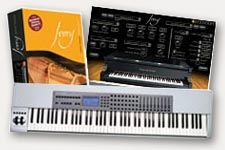 |
Plug-in and Stand-alone
Virtual instruments can often operate in one of two modes: either as a plug-in within a compatible host program such as Pro Tools, Logic, Digital Performer, SONAR, or other software DAWs, or in stand-alone mode, which means that the software can be played and programmed without requiring a host program or DAW. Stand-alone mode makes performing live with a VI easier. In either case, while a computer keyboard and mouse can be used to set parameters, a MIDI keyboard controller offers a more musical and intuitive workflow. A controller such as the Novation ReMOTE SL 25 not only adds piano-like keys for musical performance, it also auto-maps its knobs, buttons, and sliders to many software applications, giving you hardware synth-like control. For more pianistic performance, an 88-key hammer-action controller such as the M-Audio Keystation Pro 88 used in concert (so to speak) with a virtual instrument piano, such as Synthogy’s Ivory, will give you both piano-like feel and sound — with the option of functioning directly within a DAW or stand-alone (it’s much easier to carry a 47-lb. keyboard and a laptop with you than a 9-foot Steinway grand).
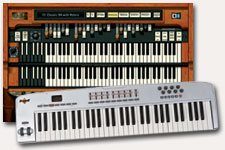 |
Using Virtual Instruments Live
One of the greatest advantages of virtual instruments is the astounding sonic power that you can take advantage of in a live setting. Imagine the ability to take a Hammond B3, a Mellotron, an ARP 2600, a Minimoog, a Fender Rhodes electric piano, a Prophet 5, and a Yamaha DX7, not mention to mention a Steinway Grand to your gigs without having to keep a stable of roadies on retainer. All you need is a laptop, a MIDI controller, and an interface. There are also hardware controllers for virtual instruments that physically emulate certain features of the actual instrument. An example would be Native Instruments B4D bundle, which provides an amazingly accurate emulation of a Hammond B3 on the software side, and a hardware controller with nine authentic-feeling drawbars plus knobs and buttons that allow you to control the stops of your organ patch just as you would with an actual Hammond organ. Plus, you can control rotary speaker speed, vibrato/chorus, percussion, recall presets on the fly, and more.
Plug-in Formats Explained
Individual plug-in formats are determined by your host program’s Application Programming Interface (API), which allows a compatible plug-in to function within the host. Many plug-ins are available in more than one format, and a few host applications support multiple plug-in formats. For example, MOTU Digital Performer can run plug-ins in both its proprietary MAS format and Apple’s AU format. Some of the more popular formats are:
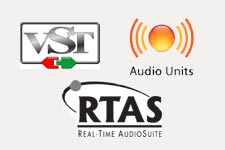 |
| · | VST (Virtual Studio Technology, with both Mac OS and Windows versions) |
| · | AU (Audio Units for Apple OS X Core Audio) |
| · | Audio Suite (a non-real-time format exclusive to Pro Tools) |
| · | RTAS (Real Time Audio Suite for native Pro Tools systems) |
| · | TDM (Time Division Multiplexing for Pro Tools hardware DSP systems) |
| · | DirectX (Microsoft’s multimedia plug-in engine for Windows) |
| · | MAS (MOTU Audio System, found exclusively in MOTU’s Digital Performer) |
Plug-in compatibility can also be expanded via a wrapper, which is software that allows a format to communicate with a different API format. For example, the FXpansion VST to RTAS Wrapper allows VST plug-ins to be used in the Pro Tools LE environment.
 |
What is ReWire?
ReWire is an inter-application communication engine developed by Propellerhead Software. It allows MIDI and audio transfer between two software applications in real time. For example, the audio output of an application such as a soft synth may be routed to another application such as a DAW mixer, and output with the second application's (mixer’s) audio. Further, they may communicate with each other via MIDI so that one can control the other or so they can be synchronized. ReWire currently works with just about every DAW application including Pro Tools, Digital Performer, Logic, SONAR, Live, ACID, and Cubase. Other applications that support ReWire include GigaStudio, Reason, Project5, and many more.
| Types of
synthesis/sounds: Naturally, this is based on your personal preferences. However, it’s always good to have more options than less. If flexibility is what you’re after, look for VIs that offer multiple synth engines. If you’re interested in creating your own unique sounds, choose a VI that either has multiple sound engines, the ability to create your own synths, or an extensive editing section. If you plan on writing music for film, or simply want numerous options for composing and music production, choose a sampler/sample player that offers compatibility with numerous sound libraries. Make sure the sound set of the VI accommodates the musical genre you’re working in. Format: Computer compatibility: RAM requirements: Plug-in and stand-alone operation User interface: Hardware compatibility: Polyphony: Latency: Company Support: |